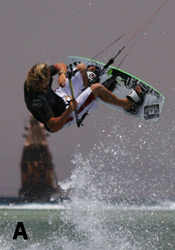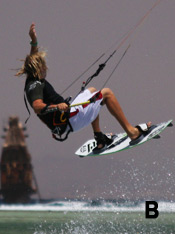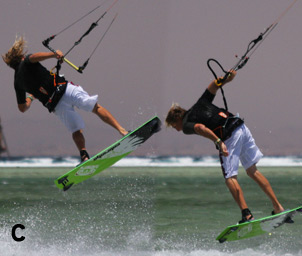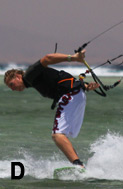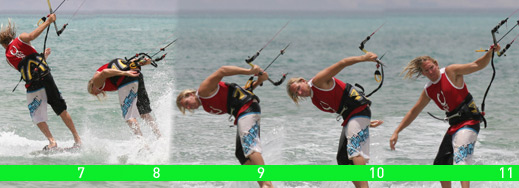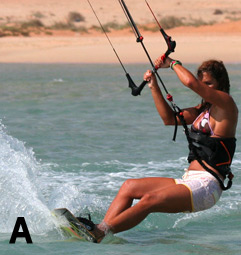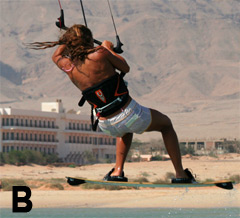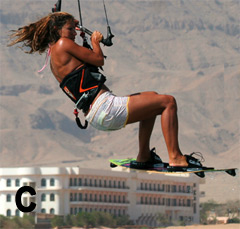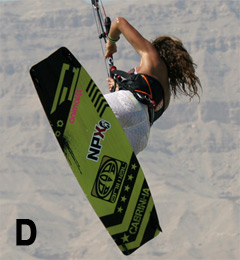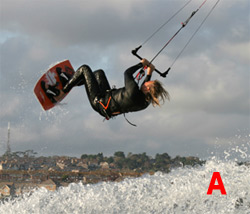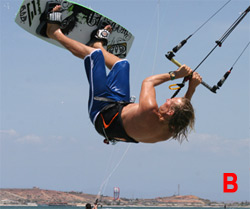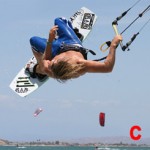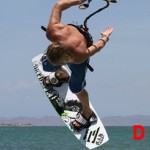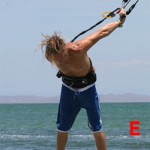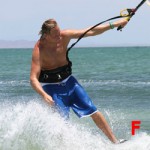Before trying Indy pop to blind trick you must be reading well below instructions and practice it with right way. You can have every possible trill which is there in kite surfing. By understanding what to do and how to do can make all the difference.
And as we have often said it’s a great way to freshen up and reignite your passion fats move that you already have in the bag – so it’ll not only look the puppy’s but also feel do booth! Here we have a hooked in pop to blind with a back hand grab on the toe side rail in between your feet. You should already have the ability to pop around to blind and ride and if you don’t then hopefully this will be the incentive you need to learn.
The Set Up- Pic A
When you search for your pop you will require two things, the obvious one being speed with a dose of power and the less obvious one is a good body position, which is always much required. Whilst learning you can afford yourself the luxury of a third one, which is lift from the kite. No need to have it down at 45° when a forgiving 1 or 11 o’clock will help you on your way. Here we can see in the image that the body position as the rider carves back up into her pop. Her front leg is extended, meaning that her hips, and weight are pushed back towards the tail of the board and her shoulders are also leaning back. Surfer adopted this position before she turned off the wind and has held it throughout her carves. This very sturdy position enables her to pop explosively off her back leg. Before we continue take note that your hands should be centered on the bar and your kite parked still.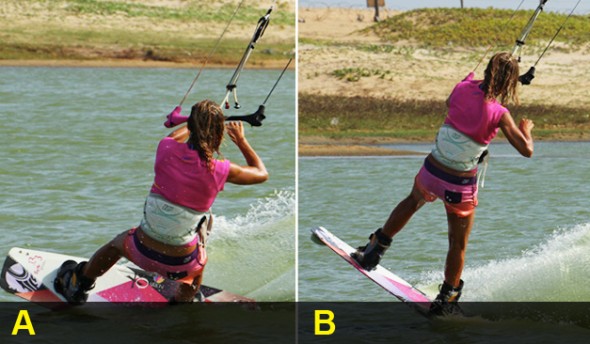
The Explosion Pic B
From such a solid set up the pop should be easy and simple. As long as you turned off the wind before carving up both the kite and the board will behave, that is to say the kite will give you something to pop against and your board won’t slow down too much as you carve. To get maximum pop you must keep your shoulders back and upwind of the board, your bum low and close to the water and you must not soften your back knee as you carve up. The rider has stamped down hard against the board with her back foot, explosively kicking herself away from her edge, and with her weight back and she takes off nose first. In anticipation of not having much time to grab she is already releasing her back hand from the bar as she stamps.
Board Up Pic C
As with any pop you need to wait until you’ve extended your body to get full elevation up, but as soon as you have it’s chop-chop to get the grab in. In picture, having already released hand, her next job is to bring her knees up towards her so that the board is within grabbing distance. The rider looks down towards where she’ll grab as she lifts the board and keeps her knees apart so that there is room for her arm to reach down towards the edge of the board. Also as a result of popping hard the back of her board kicks around and out slightly which has the effect of turning the rider back and away from the kite. This is good as it pushes which in turn gives her more room to reach down with her back hand.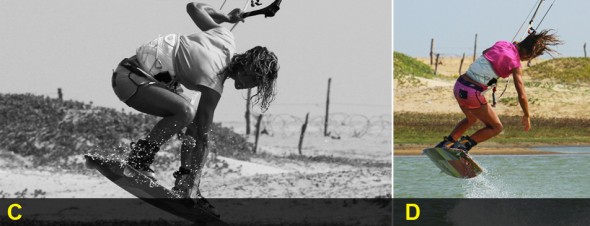
The Grab Pic D
With the board flicking around, roots for the back hand to reach down and the knees pulling everything up she can happily grab the board for a solid Indy. In this picture you can see the result of all that has gone before – the bar is in front of her and she has plenty of roots to reach and hold the grab without the need to be a contortionist. Whilst you have the grab sirs to keep the bar in on the sweet spot so that you’ll have a modicum of support from the kite, you’ll keep your forward momentum for the landing, and you’ll be able to dump the pull when you need to turn to blind.
Throw the Blind Pic E
A very good thing about the grab is that it naturally makes you stall your turn or throw to blind. Blind is always a last second movement, hence why we can do a by pop to blind. The higher you go, the longer you have to wait in order to keep your balance and control the landing. Once you feel that you’ve got the grab and you know that you’re coming data it’s time to turn. The action will come from your hips and your back leg whilst your free arm will balance you. The rider has released her grab and now commits to blind. To turn the board she twists her hips and pulls her back leg up towards her bottom and around towards the water. The board will naturally want to fall tail first so she focuses on pulling her back leg up. By doing this she will rotate around her harness hook and should make it all the way.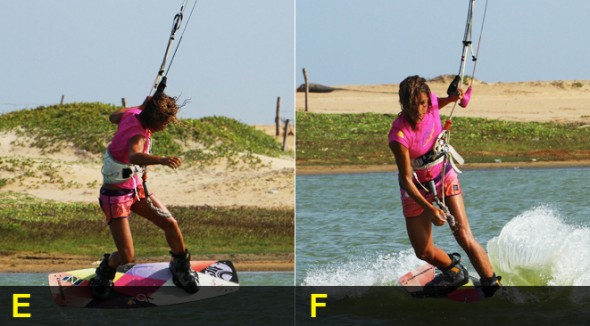
Landing Pic F
Landing this should be as per your pop to blind, though chances are as you’ve had more height you will have less momentum to keep you going once you plant the board. Make an effort to keep your back foot up so that you can plant the front of the board into the water for landing. This way as the nose catches the board will pivot off the wind more and you’re more likely to keep moving. If you land flat on your edge you’ll just stop. You can see that the rider has landed nose first with her front leg fairly straight, whilst her back leg is bent so that the board will turn further away from the wind on landing
She is already in her default blind position so that she will keep moving. If you have slowed too much pull the bar in to get some oomph from your kite.
Top Tips
- First of all you should practice the Indy if you never tried it before.
- Getting the board flicking you slightly around on take-off does make the movement of turning to blind in the air much easier as you have less far to turn and thus your body is in a better position.
- Try looking back at where you came from as you grab, this will help you turn during your Indy.
- Although we’ve said you don’t want your kite too low, don’t have it any higher than 11 or 1 o’clock. It still needs to be pulling forward to allow for some flick, an easy grab, and momentum on landing.
Common Problems
- If you can’t reach to the grab then ensure you’re popping hard enough. The pop will help you lift the board as the water will cork the board back up at you.
- Also make sure you turn to face slightly back to get the bar and your harness out of the way.
- If you’re falling backwards as you land. If your body is further downwind than the board when you land you need to sheet the bar out as you throw the blind.
- If you’re landing and then falling chances are that you’re landing flat or tail first, so concentrate on keeping that back foot up and close to your bottom so that the board can pivot.
Keystones
- Turn up and pop hard
- Release back hand and look for grab
- Lift board and look back
- Throw to blind using hips and back leg
- Keep back leg up to land nose first
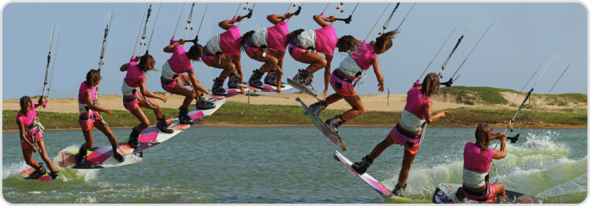
 you swing yourself into this and therefore your jump needs to be more send than bow. You can see in images that rider has given the kite a good send by the angle of his bar. Over here the push and pull action is very important as you’ll have your hands very centered so that you don’t make any rash moves once you’re up, but this does mean that your hands have less impact when you send the kite back. You need a decent send to give you the height and get you flying with the kite behind 12. If you don’t send it past 12 and just pull in for lift you will redirect the kite too much once you go for the table top. How far back you go will depend on kite size and wind strength, nothing too extreme as you still want float. Needless to say Christian has a good edge coming into this and he is looking upwind not at the kite.
you swing yourself into this and therefore your jump needs to be more send than bow. You can see in images that rider has given the kite a good send by the angle of his bar. Over here the push and pull action is very important as you’ll have your hands very centered so that you don’t make any rash moves once you’re up, but this does mean that your hands have less impact when you send the kite back. You need a decent send to give you the height and get you flying with the kite behind 12. If you don’t send it past 12 and just pull in for lift you will redirect the kite too much once you go for the table top. How far back you go will depend on kite size and wind strength, nothing too extreme as you still want float. Needless to say Christian has a good edge coming into this and he is looking upwind not at the kite. that the kite is where you want it, just behind 12 o’clock. There is no great rush as you won’t be able to hold the one handed position indefinitely. As the rider launches himself skywards he brings the bar in to make sure that he’s got tension on the lines for float, and this also lets him feel if the kite is supporting him and from where – you’ll feel the kite pulling from anywhere but up if it’s in the wrong place!
that the kite is where you want it, just behind 12 o’clock. There is no great rush as you won’t be able to hold the one handed position indefinitely. As the rider launches himself skywards he brings the bar in to make sure that he’s got tension on the lines for float, and this also lets him feel if the kite is supporting him and from where – you’ll feel the kite pulling from anywhere but up if it’s in the wrong place! d, your body and legs will turn too. Looking down allows your shoulders to drop, which will lift the board a little. The movement itself is fairly simple, almost like throwing a blind in the air.
d, your body and legs will turn too. Looking down allows your shoulders to drop, which will lift the board a little. The movement itself is fairly simple, almost like throwing a blind in the air.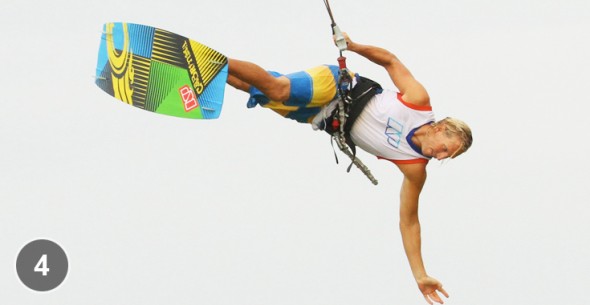


 . Preferably you’ll wish some power in the kite, a jolly good edge and some space. Start with your kite no higher than 11 or 1 o’clock. Once you know it’s there,
. Preferably you’ll wish some power in the kite, a jolly good edge and some space. Start with your kite no higher than 11 or 1 o’clock. Once you know it’s there,

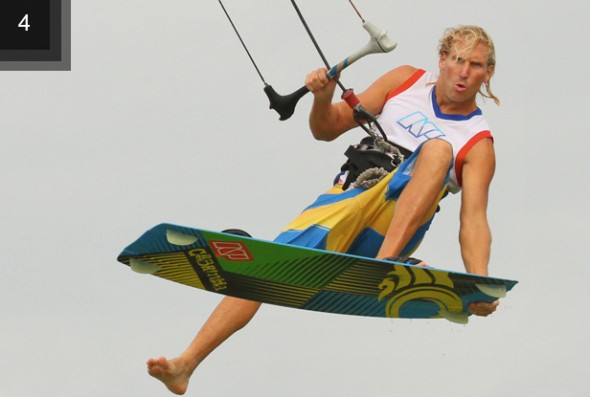


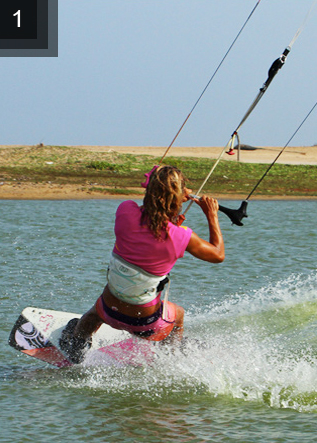
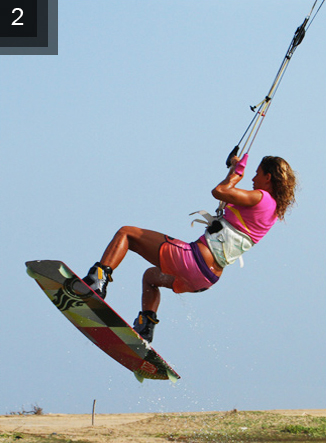 ’t mean that you must be holding the board as soon as fins departs the water, however if you place your body in right position then grab will be trouble-free to obtain. Rider lifts both knees up and this helps with slowing the rotation down. Also you can’t toss your head around into the rotation if you are seeking a firm grab.
’t mean that you must be holding the board as soon as fins departs the water, however if you place your body in right position then grab will be trouble-free to obtain. Rider lifts both knees up and this helps with slowing the rotation down. Also you can’t toss your head around into the rotation if you are seeking a firm grab.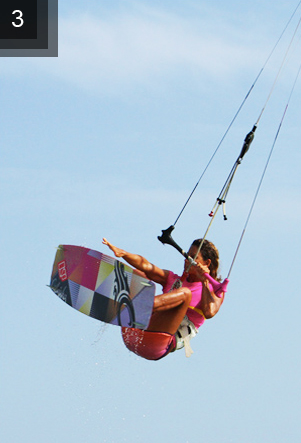
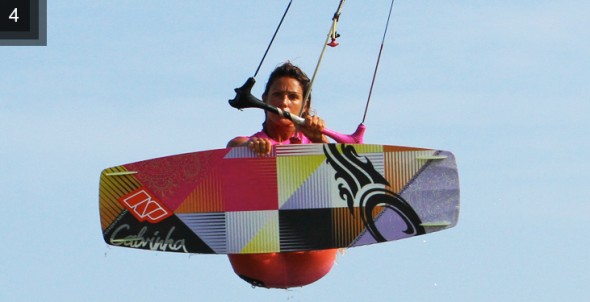
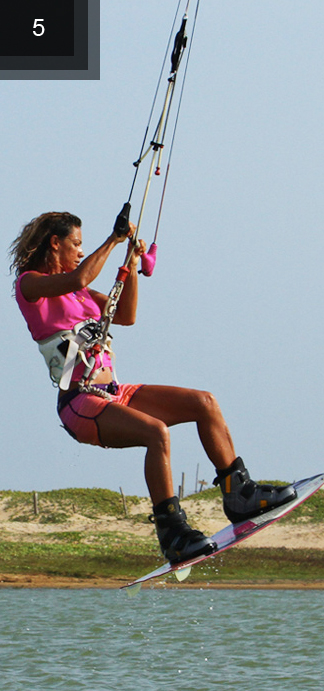 t landing. Mark your landing and obtain the board pointing downwind.
t landing. Mark your landing and obtain the board pointing downwind.